Ever wonder how to cook a whole salmon? I got you covered with this simple and elegant Whole Roasted Salmon with Sumac, Aleppo Pepper and fresh herbs. A classic fish paired with Middle Eastern flavors.
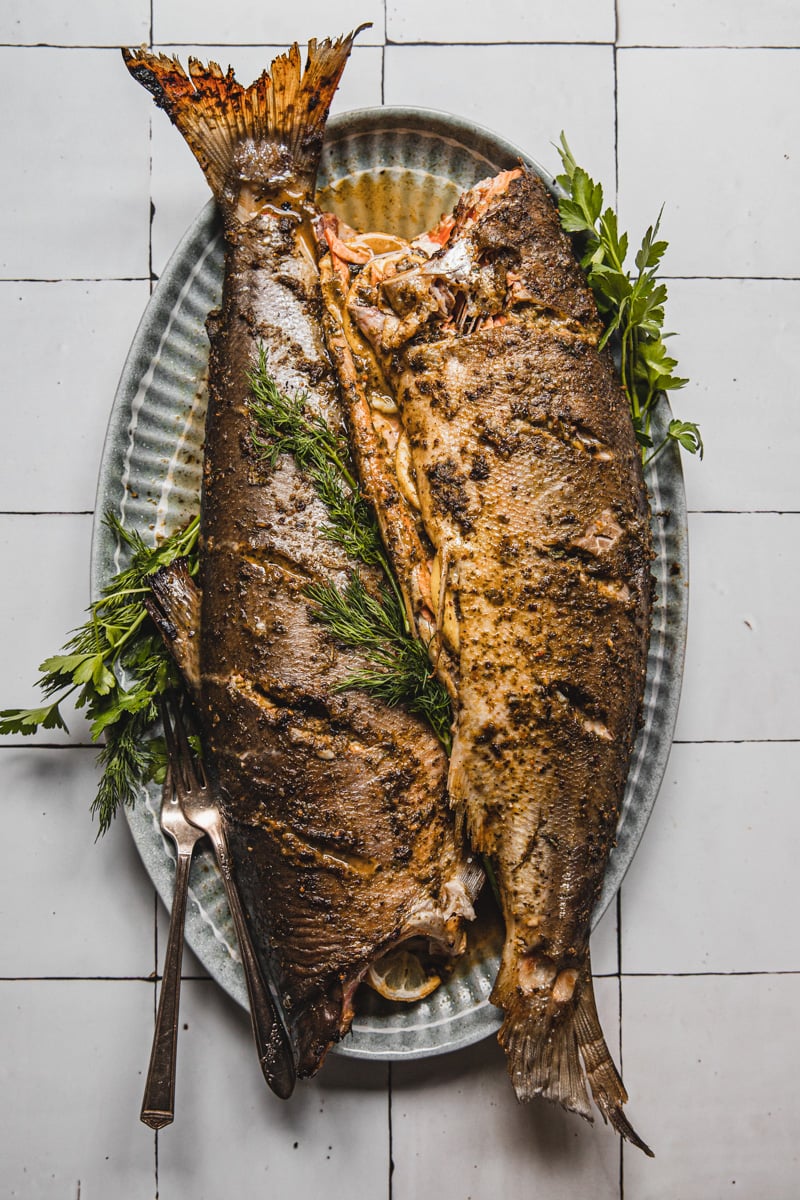
We are entering what is one of my favorite times of year - Salmon season!!! Roasting a whole salmon is easier than you think. Today I'm sharing a simple Whole Roasted Salmon seasoned with Sumac, Aleppo Pepper and fresh herbs. The tangy spices lend themselves well to this meaty fish. Whether you enjoy just snacking on the fish or toss it in a pasta dish, you can certainly replace crab for salmon in one of my favorite 20 minutes one pan pasta dishes or my Caesar pasta salad!
Purchasing a whole fish can be a little costly, but when you realize how much fish you end up with, it's actually more affordable than purchasing fillets. And the flavor is just superb. Let's chat about the types of salmon!
Types of Salmon
There are a variety of salmon in the markets, they will also range significantly in price ands size. I'm using Coho Salmon in my recipe today. I like to stick with Chinook or King, Sockeye or Coho when purchasing salmon over Atlantic. Atlantic salmon is farmed and will often have a pink hue versus a bright red color like Chinook or King, Sockeye or Coho.
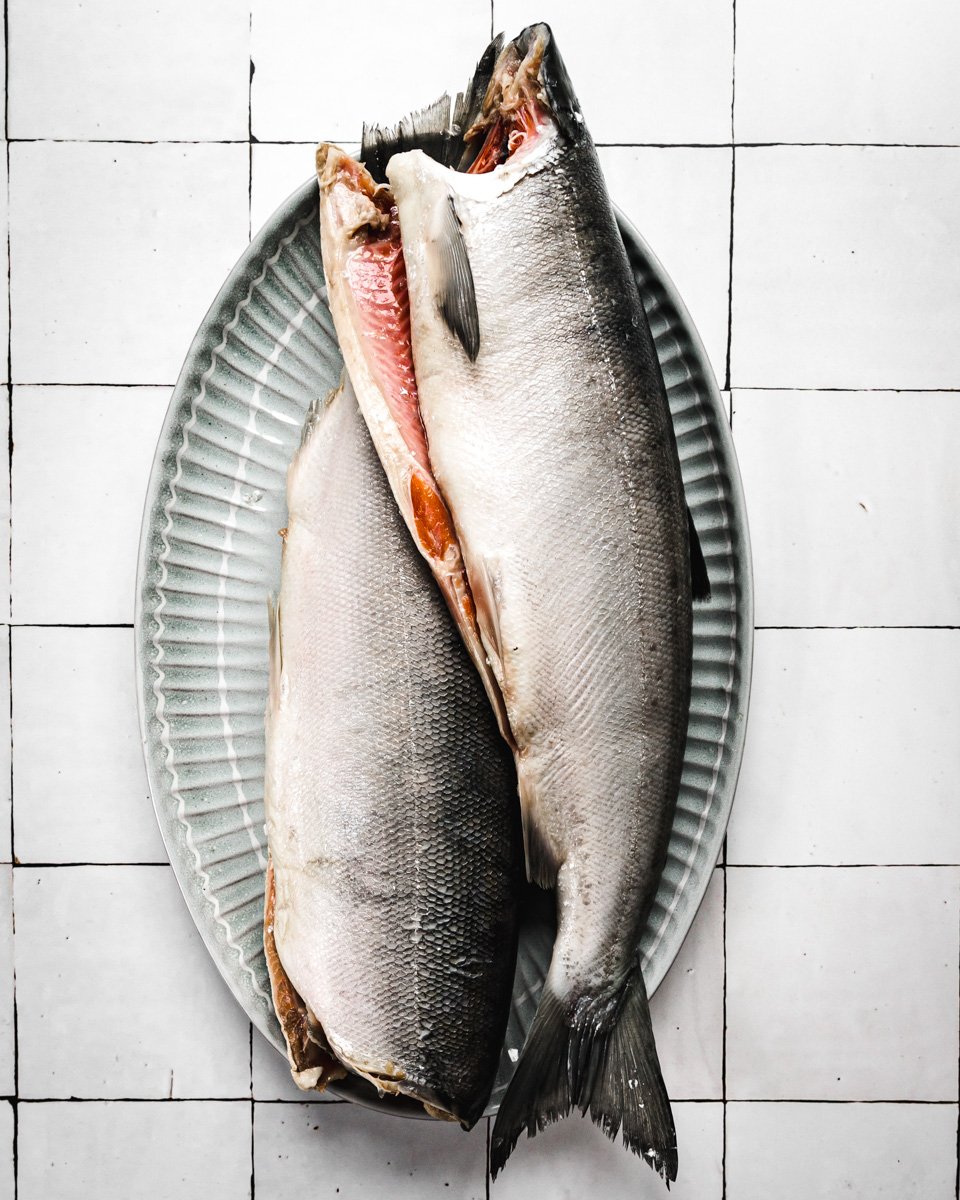

Copper River Salmon is some of the finest - you can learn more about the different types here on their site as well.
- Chinook Salmon/King - Prized for its exceptionally high oil content, succulent texture and rich flavor, this luxury fish literally melts in your mouth. Also known as Chinook, this fish is the largest of the three species and boasts the highest oil content of the three species.
- Sockeye Salmon - Also known as Red salmon, sockeye is robust and rich in flavor with a firm texture that makes it versatile for any cooking method. Famous for its natural deep red flesh, sockeye is the most abundant species in the Copper River Delta.
- Coho Salmon - Approachable mild flavor and delicate texture distinguish this affordable, late-season species.
Information sourced from Copper River Salmon
A sampling of ingredients
The star of this dish is the salmon itself, I am using 2 whole Coho Salmons on the smaller side. Each was just about 2.5 pounds. These were previously frozen and cooked up beautifully!
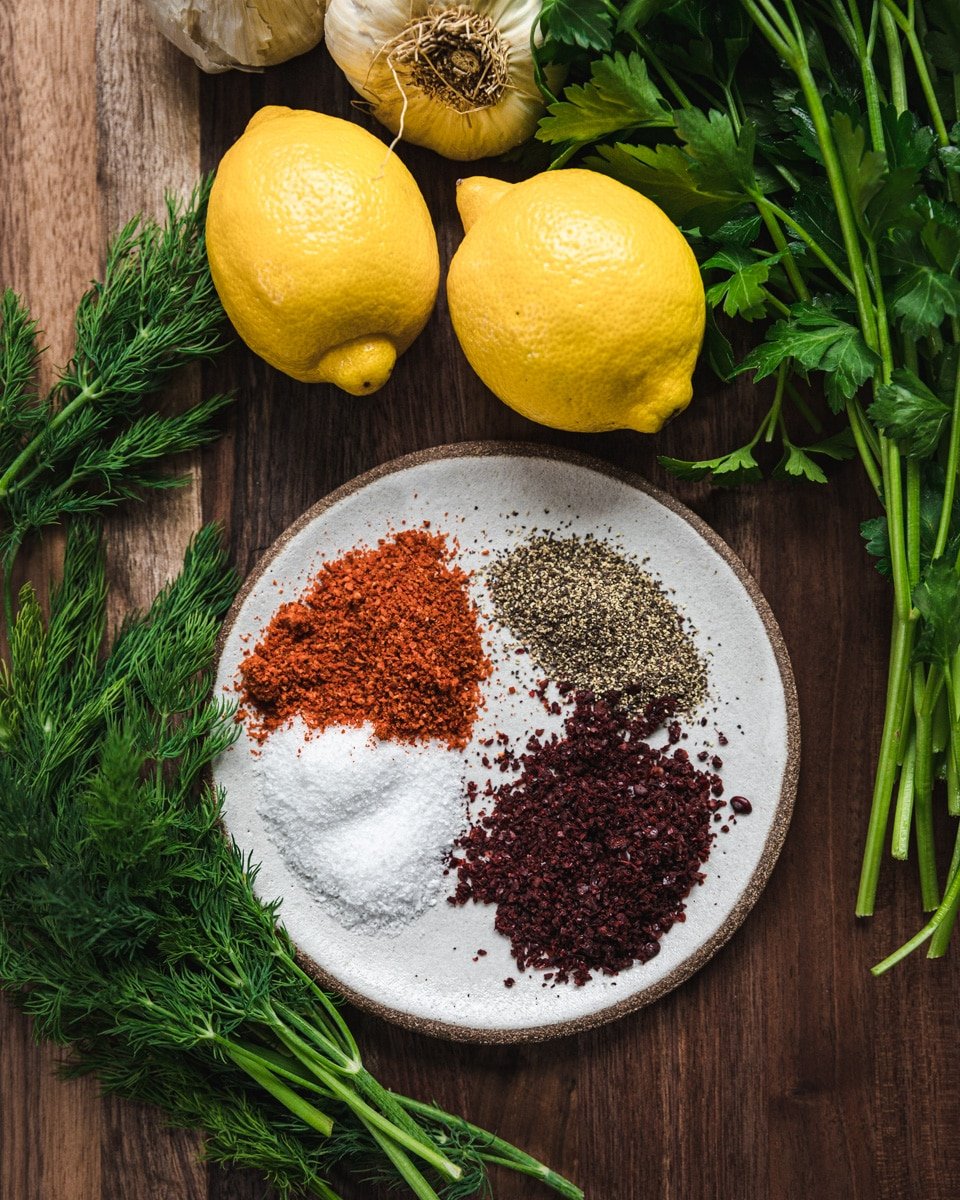
- Wild Caught Whole Salmon - When purchasing your salmon, be sure they are gutted and typically they are sold without the head (most ideal). Some may already be descaled but many are not. I'll walk you through descaling your fish - very easy with this simple tool.
- Lemons - Fresh lemons are the perfect accompaniment with any fish and key for this recipe. We'll use it in our rub as well as stuff the salmon with extra lemon.
- Sumac - If you are not familiar with sumac spice - you should be!!! It's a Middle Eastern spice that has a bold lemon flavor. It is the perfect spice to enhance our salmon without adding too much liquid. This is one of my favorite brands - it's bold and bright in flavor.
- Aleppo Pepper - Another fun spice if you are not familiar. Aleppo pepper is not extremely spice but has a lovely warm flavor.
See recipe card for quantities.
Instructions for Roasting Whole Salmon
Herb Rub
Prepare your rub/marinade by placing the juice of 2 lemons, salt, sumac, Aleppo pepper, black pepper, parsley, dill, garlic and olive oil into a food processer or blender. Be sure to stop and scape sides down as needed. Once combined, set aside and prepare your fish.
Descaling
If you need to descale your fish, set up an area and lay fish on foil or paper bags to descale. Using your tool, slowly move along the skin in the opposite direction of the scales. The scales will begin to pop off exposing the smooth skin. Once you are done on one side, flip and repeat until scales are removed.
With a damp paper towel, wipe the fish down on all sides and place on a foil lined sheet pan ready to prepare and bake.
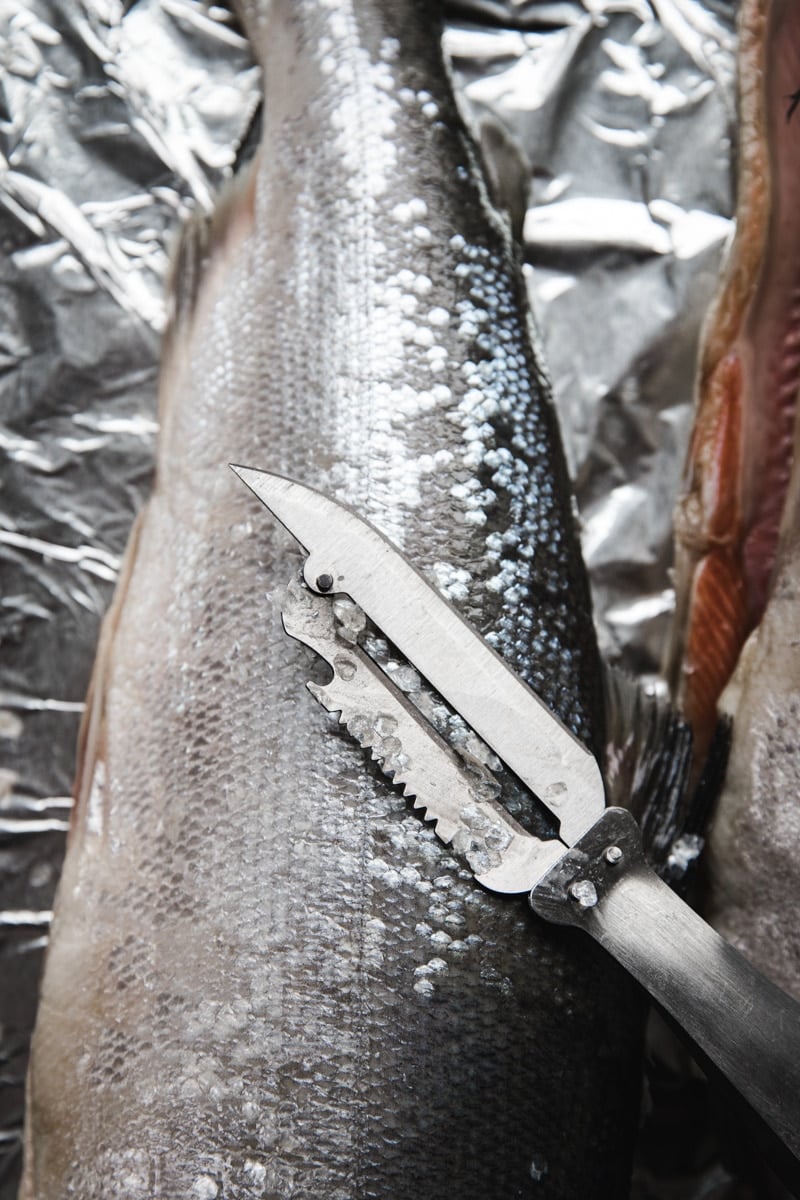
Preparing to Bake
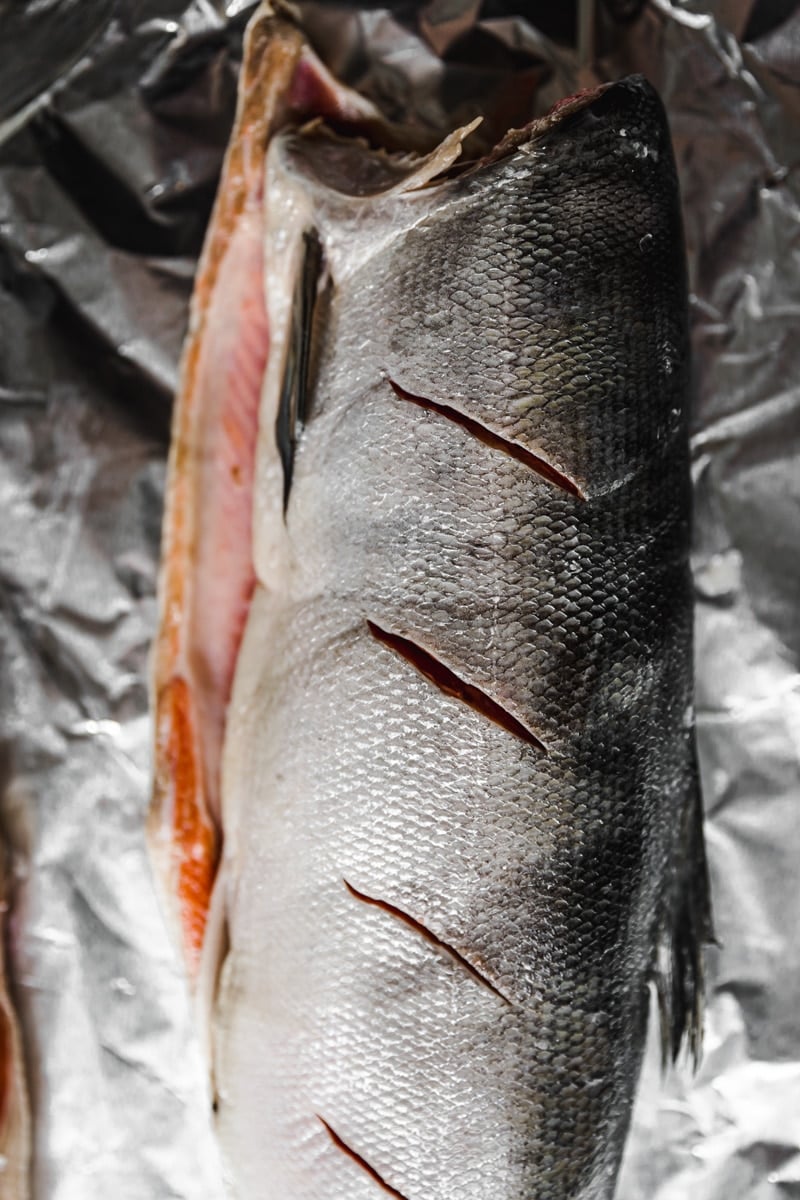
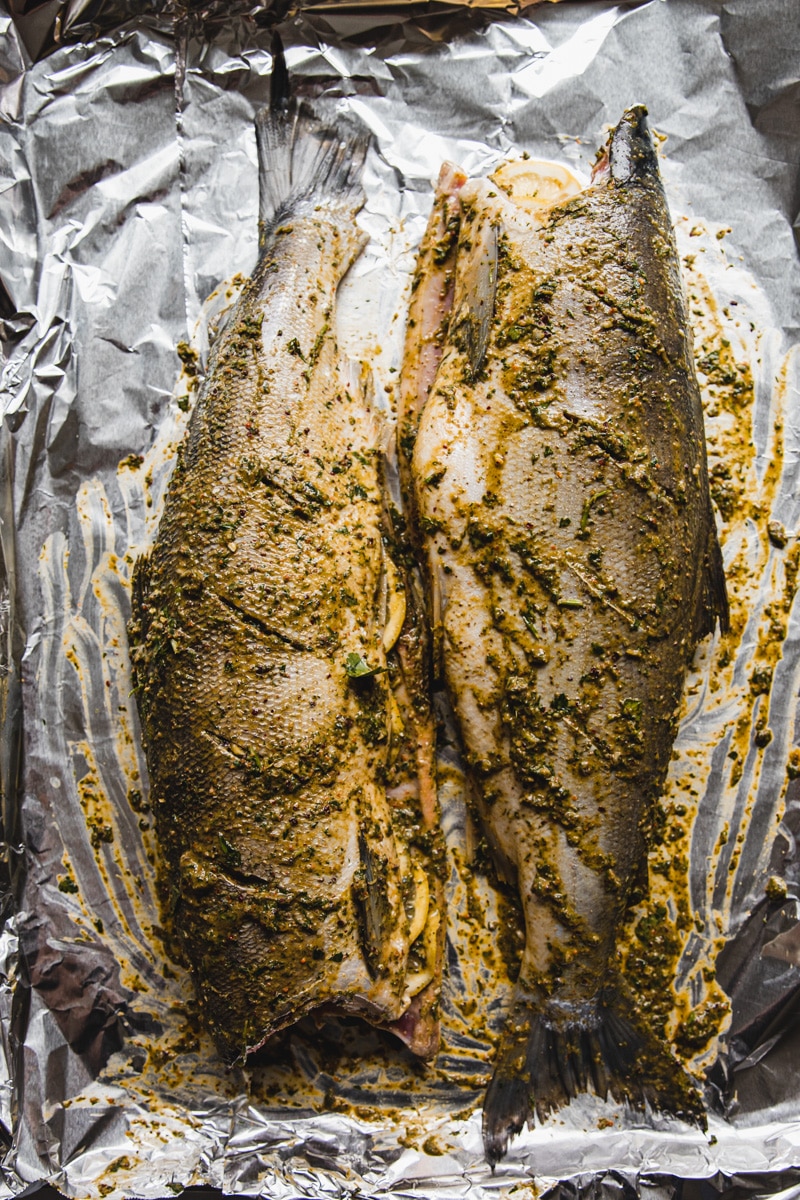
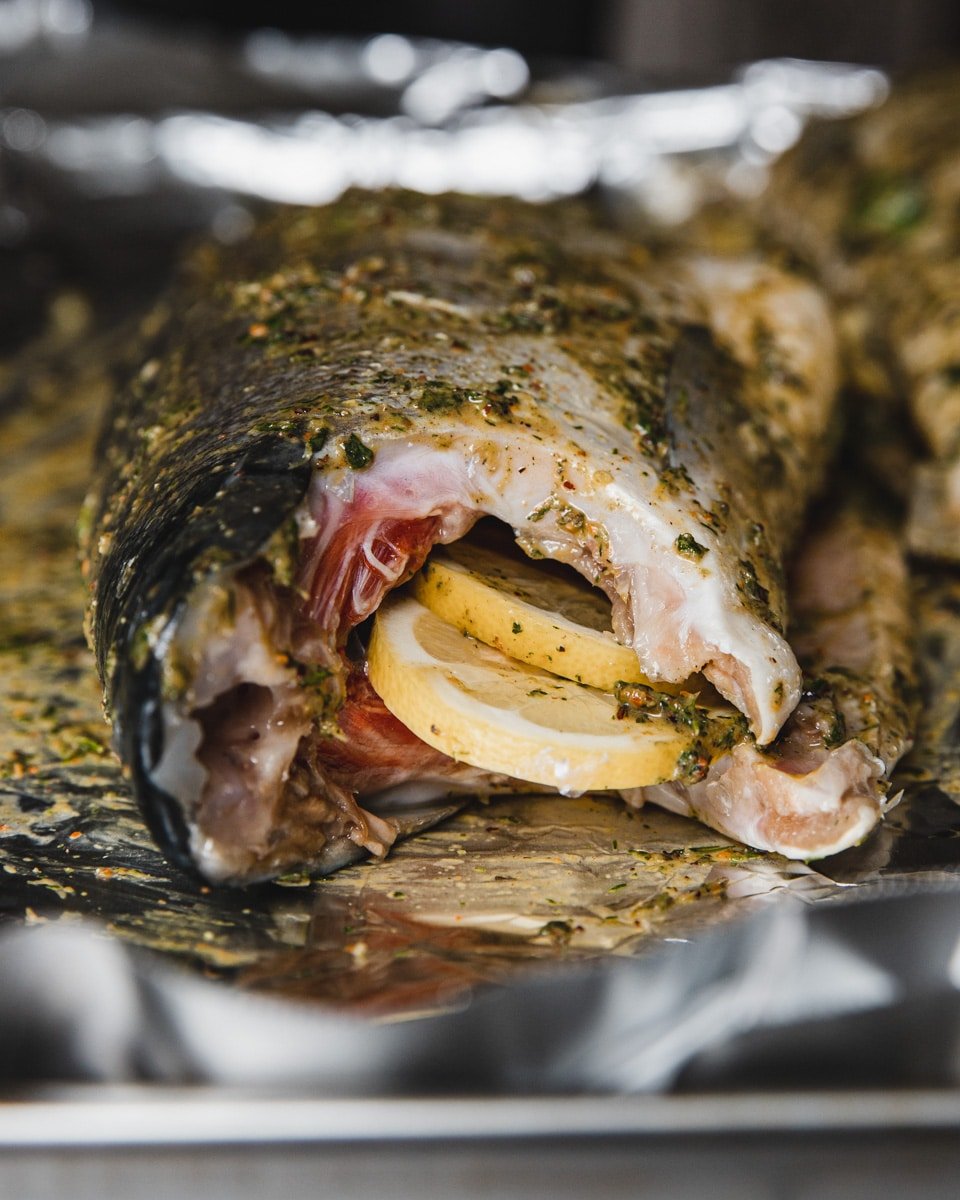
- Once your fish is descaled, begin preparing to bake. Prepare a half sheet or ¾ sized sheet pan lined with foil.
- Place your fish lengthwise or diagonal if it's too long. With a sharp fish or chef's knife, make 4-6 incisions on the side of your fish. Incisions should be about ½", just enough to break the skin and allow for a little space for our herb rub. Continue on the 2nd side and 2nd fish if baking two.
- Using clean hands, place spoonfuls of your herb rub on the salmon both inside the cavity and within the slits on the outside. Try to get as much of your rub inside the slits and remaining rub will coat the exterior of your fish. Finally, add additional lemon slices and extra dill inside the fish cavity. You can wrap your fish in butcher's twine if you'd like, but I find it unnecessary.
- Bake your fish in the middle rack for 20-30 minutes at 425 degrees Fahrenheit. The last few minutes you can broil your fish skin for 2-3 minutes to get an extra char. Fish at the thickest point (usually toward the top, just under where head was removed). You want the fish to be between 125°F and 140°F, I aim for about 125°F. 110°F to 125°F (43°C to 52°C ), the fish is medium-rare. Between 125°F and 140°F, it’s medium to well-done. You don’t want it to reach above 140°F (60°C) otherwise it will be overcooked. I love my digital thermometer, a worthy investment for less than $20!!! - More tips on how to tell when salmon is done.
- Remove from oven and allow to rest for 5-10 minutes. Serve with pan juices and extra lemon.
This recipe is naturally gluten free and perfect for pescatarians.
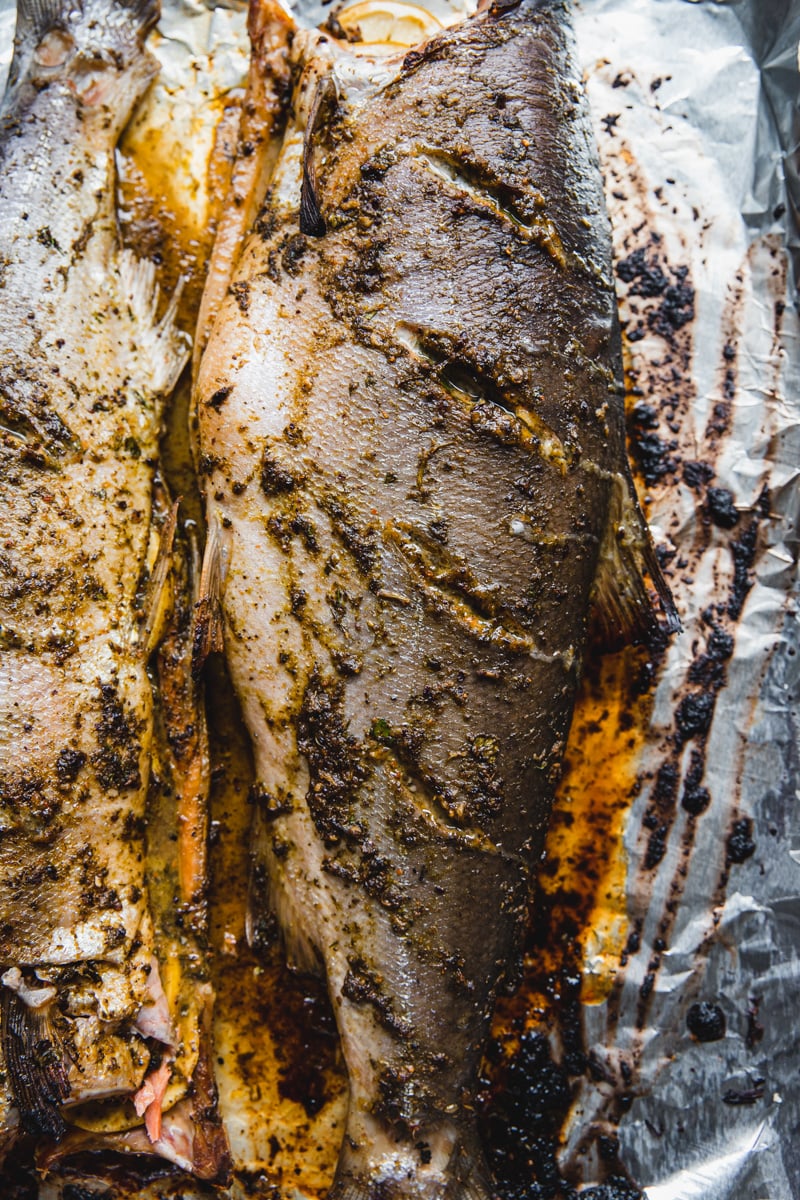
How to Store Salmon
Remove salmon from the bones and remove bones from any salmon pieces. Once you have done this, store salmon in an airtight container in the fridge up to 3 days.
You can also freeze salmon, take fillets or pieces of salmon and place in a freezer safe bag, remove any air and seal for freezer. Good for up to 3 months and perfect for pasta dishes, salmon salad or a salmon bake.
How to Reheat Salmon
My personal preference is to enjoy the leftover salmon cold, especially in a salad and some fresh baked bread, this no knead recipe is so good! . If you'd like to reheat salmon, heat a bit of butter in a skillet on medium heat, add your salmon and cook slow and low. Add additional lemon, salt and I also love capers with it. Serve with some sautéed vegetables, green beans or asparagus are great this time of year. DO NOT MICROWAVE!
Pro Tip
You don't want your salmon to be overcooked - if your salmon is on the smaller size, begin checking temperature at 15 minutes, if your salmon is larger, it may need some extra time. If you don't have a thermometer, take a small knife and slightly cut into the salmon. You don't want it to begin flaking, but rather be able to break into a chunk. It should still have pink/red color on the inside as well. More tips on how to tell when salmon is done.
I hope you love this recipe as much as my family does, it's a wonderful way to enjoy fish in an affordable way. Be sure to check out our FAVORITE Caesar Salad recipe that we use this salmon with!
As always, I love seeing your creations. Please leave a review or share your dish with me on social media #cosetteskitchen, I love resharing your photos! You can find me on Facebook, Instagram, Twitter , Tiktok and Pinterest. For more delicious recipes to your inbox, sign up for my newsletter!
xoxo,
Cosette
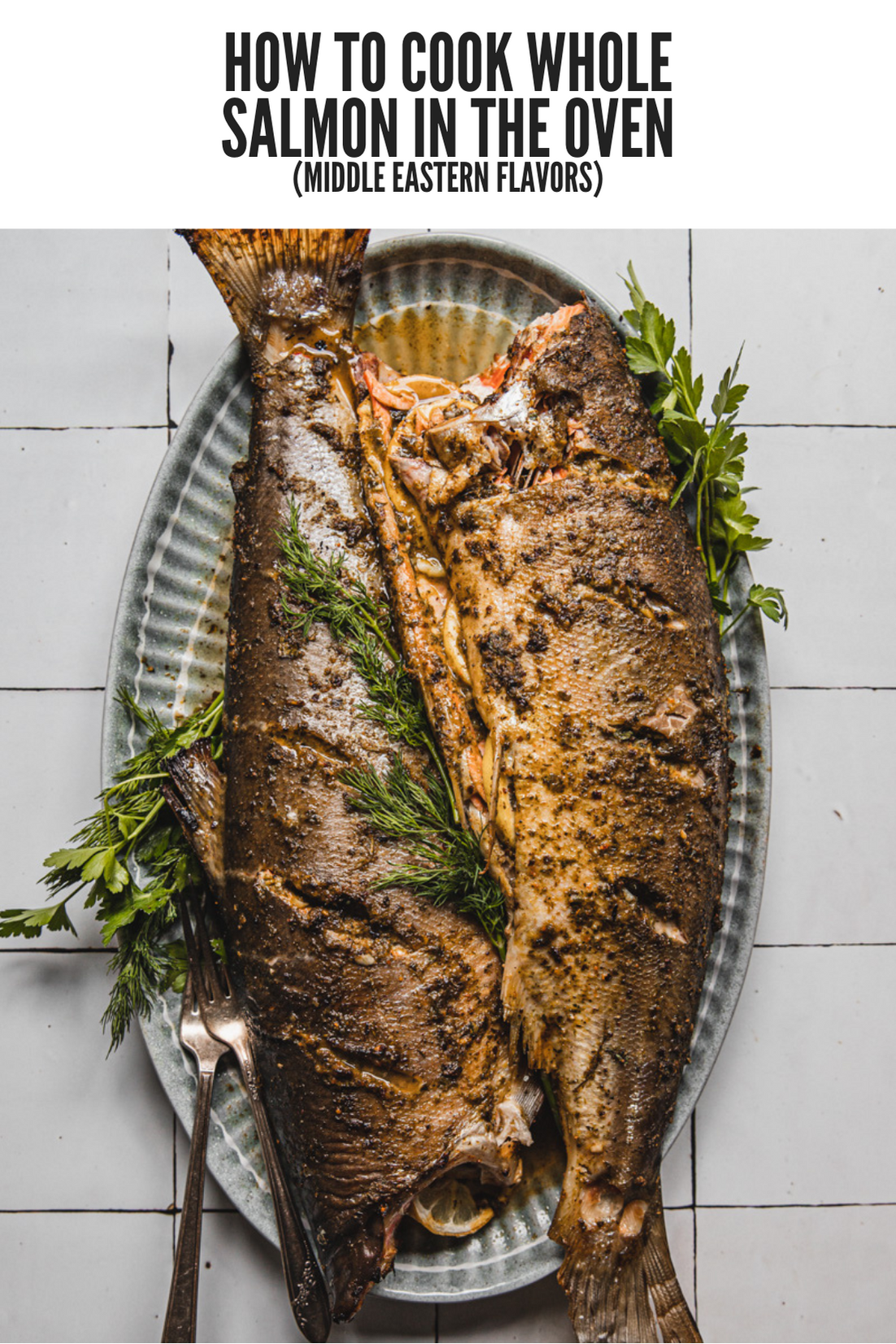
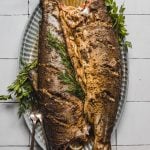
How to Cook Whole Salmon in the Oven
- Prep Time: 15 minutes
- Cook Time: 30 minutes
- Total Time: 45 minutes
- Yield: 2 whole fish 1x
- Category: Dinner
- Method: Oven
- Cuisine: Middle Eastern
Description
Delicious whole Coho Salmon is cooked to perfection in the oven. Filled with Middle Eastern spices and tangy lemon flavor. This recipe is for 2 whole salmons, feel free to adapt to one or make the entire rub and use the excess after fish is cooked.
Ingredients
- (2) 2.5/3 pound whole salmon - gutted and descaled
- 4 lemons, divided
- 2 teaspoons kosher salt*
- 2 teaspoons sumac spice
- 1 ½ teaspoons Aleppo pepper
- 1 teaspoon black pepper
- ½ bunch of fresh flat leaf parsley, about a cup - stems removed
- ½ bunch of fresh dill, about ½ cup - stems removed + extra for stuffing in fish.
- ¼ cup olive oil
- 8 whole cloves garlic
Instructions
- Preheat your oven to 425 degrees Fahrenheit (218 C) and place rack in center of oven.
- In the bowl of a food processor or blender, place the juice of 2 lemons, salt, sumac, Aleppo pepper, black pepper, parsley, dill, olive oil and garlic. Blend on high until a paste or rub forms. Set aside and prepare your fish.
- Begin by preparing your fish. Ensure it is gutted and descaled - see process in post.
- Line a large sheet pan with heavy duty foil. Place your cleaned fish on the foil and begin by making 4-6 diagonal incisions on each side of the fish. The incisions should be about ½" deep, just enough to be able to allow the herb rub to fill.
- Repeat on 2nd fish.
- Divide your rub and begin coating the fish with it - apply to the inside of the fish and then exterior, making sure to allow rub to fill each incision.
- Slice your last 2 lemons and insert slices into each fish with some additional dill.
- Bake your fish in the middle rack for 20-30 minutes at 425 degrees Fahrenheit. The last few minutes you can broil your fish skin for 2-3 minutes to get an extra char. Fish at the thickest point (usually toward the top, just under where head was removed). You want the fish to be between 125°F and 140°F, I aim for about 125°F. 110°F to 125°F (43°C to 52°C ), the fish is medium-rare. Between 125°F and 140°F, it’s medium to well-done. You don’t want it to reach above 140°F (60°C) otherwise it will be overcooked. I love my digital thermometer, a worthy investment for less than $20.
- Remove from oven and allow to rest for 5-10 minutes. Serve with pan juices and extra lemon.
Notes
**If using salt other than Kosher Salt, half in the recipe
**The marinade/rub can be stored in the fridge up to 5 days - it's great to use with any protein.
Food safety
- Cook to a minimum temperature of 110 °F (43 °C)
- Do not use the same utensils on cooked food, that previously touched raw meat
- Wash hands after touching raw meat
- Don't leave food sitting out at room temperature for extended periods
- Never leave cooking food unattended
- Use oils with high smoking point to avoid harmful compounds
- Always have good ventilation when using a gas stove





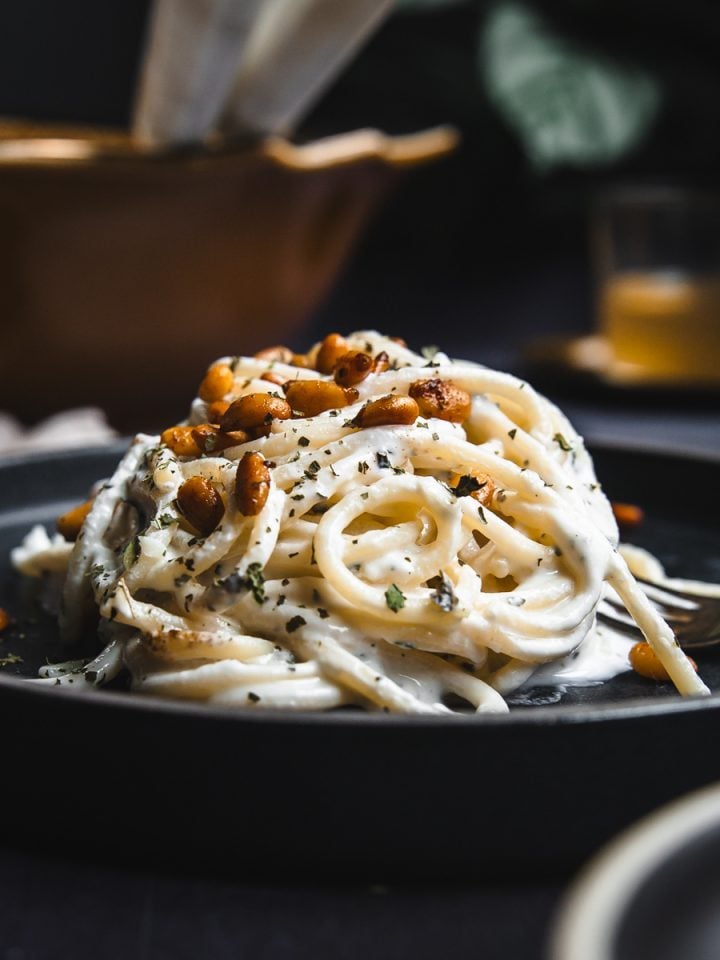
Ayesha says
This was truly amazing. I was looking for a whole salmon recipe that was a little different from the usual lemon and herbs routine and I found it. The sauce is incredible on its own: fresh and herby, lemony and savoury. I tossed some potatoes in it and roasted them along side the fish. Perfect. My husband said that fish was lucky to find our kitchen. I say we were lucky you shared this recipe. Thank you!
Cosette's Kitchen says
Thank you so much for your kind review, so happy your family enjoyed it so much!!!
xoxo,
Cosette
Alicia says
Fish image looks burnt. Detours individuals from using this recipe.
Cosette Posko says
I can assure you the fish is not burnt. The skin does brown from cooking but also the dark spices. Hope you had an opportunity to try the recipe.
Cosette